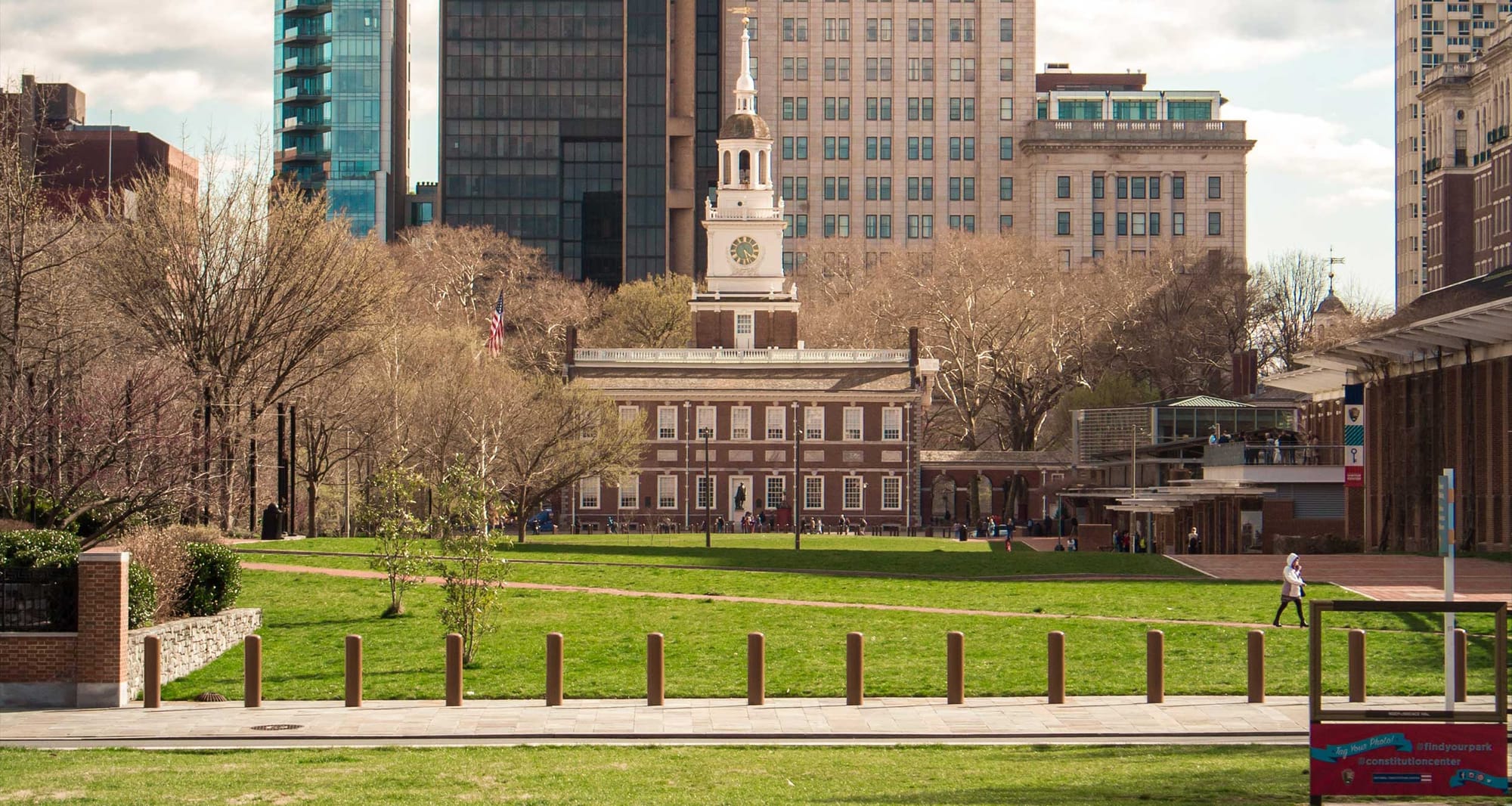
Philadelphia is a vibrant city that offers tourists an opportunity to experience diverse history, art and culture within a relatively compact space. The city’s most popular attractions—Independence Hall, the Liberty Bell, LOVE Park and the Philadelphia Museum of Art—are all wheelchair accessible. Plan your itinerary with this list of wheelchair accessible attractions in Philadelphia and enjoy exploring the city where the American republic was formed.
Please note that while admission to some of the most popular attractions is free, many others carry a fee. If you plan to visit paid attractions like the Constitution Center, the Franklin Institute and the Museum of the American Revolution, I recommend purchasing the Philadelphia CityPASS, which offers a savings of up to 48% off the cost of admission. If you purchase a CityPASS through one of my links, I may receive a small commission at no cost to you. Thank you for your support!
Independence Hall (National Historic Park)
A UNESCO World Heritage Site, Independence Hall was one of the most important meeting places in early American history. Completed in 1753, the building first housed Pennsylvania’s colonial government. From 1775 to 1881, the then-state house served as the meeting place for the Second Continental Congress, except during periods of British occupation of Philadelphia. On July 4, 1776, during a meeting of the Second Continental Congress, the Declaration of Independence was approved.

More than a decade later, in 1787, representatives from 12 of the 13 states met at Independence Hall to amend the Articles of Confederation, an agreement which had established a loose bond between states during the Revolutionary War. On September 17, 1787, delegates of what had become a Constitutional Convention approved and signed the Constitution of the United States, sending it to the states for ratification. 39 of 55 delegates signed the document, including Benjamin Franklin, Alexander Hamilton, James Madison and George Washington.
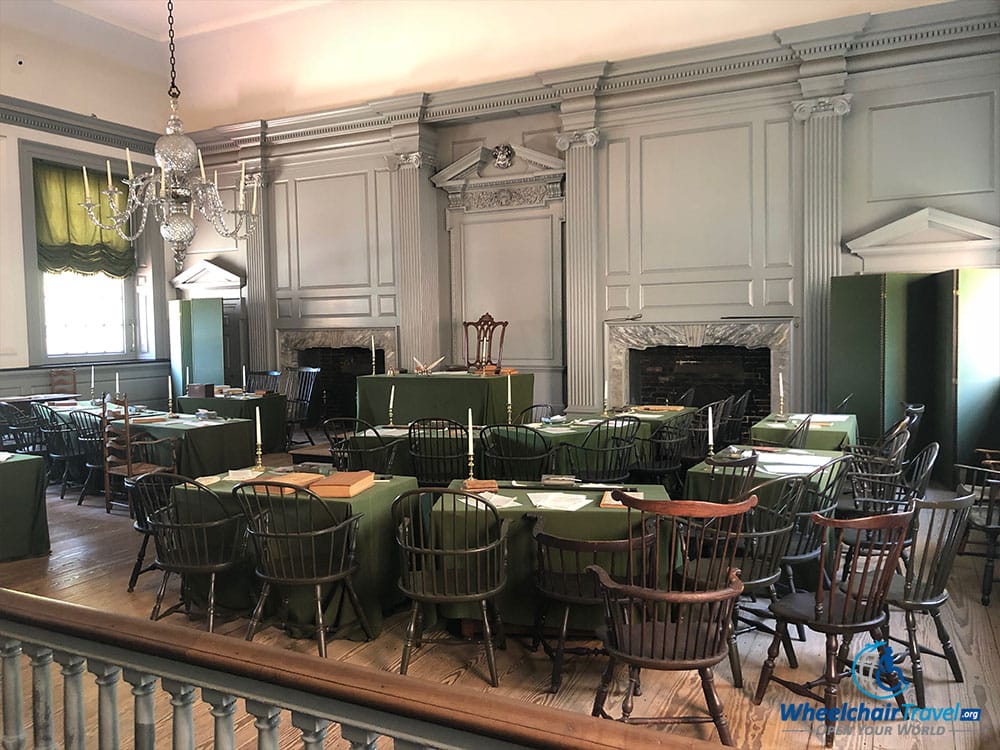
Generations of Americans have worked to preserve Independence Hall for posterity. Now maintained by the National Park Service and a part of Independence National Historic Park, Independence Hall is open to visitors of all abilities. Ramps provide wheelchair access throughout, with the exception of the second floor of Congress Hall (a separate building on park grounds). Admission is free of charge, but timed entry tickets are required from March through December. Tickets are distributed each day beginning at 8:30 a.m. at the Ranger’s Desk in the Independence Visitor Center, located at 6th and Market Streets – two blocks from Independence Hall.
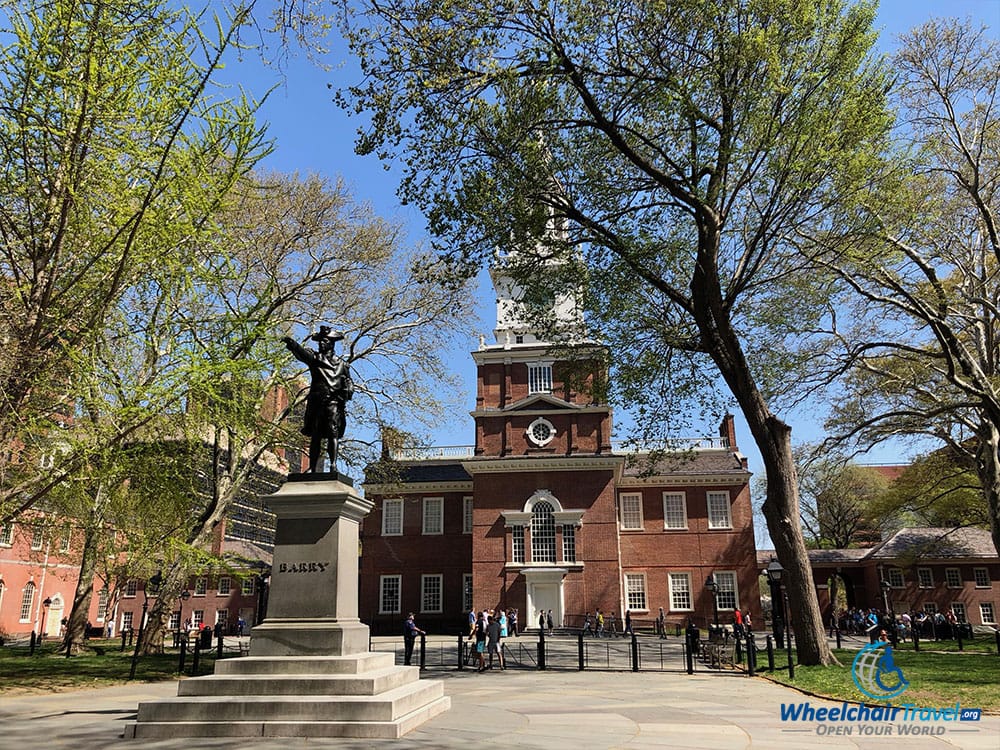
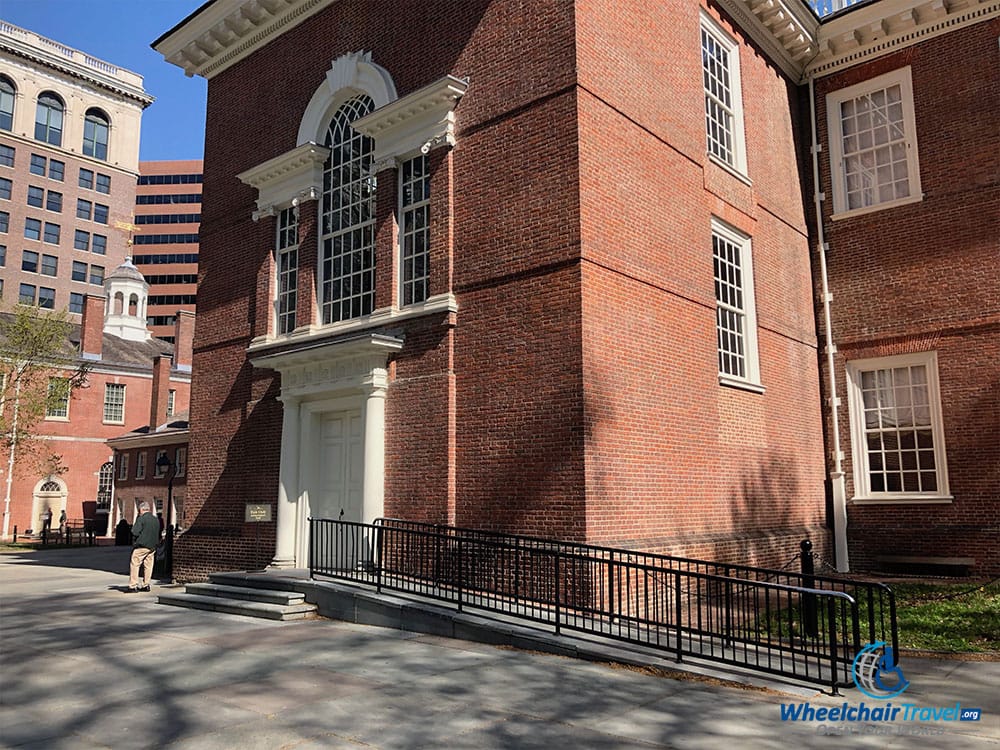
With ticket in hand, proceed to the security tent at least 15 minutes prior to the time indicated on your ticket. Bags and purses are screened by x-ray and visitors pass through a metal detector. Wheelchair users receive a light pat down. Tours of Independence Hall last 30 minutes and are guided by a park service volunteer. Once the tour has finished, visitors are free to explore Congress Hall on a separate guided tour which runs every 30 minutes. While only the first floor is accessible, it is a worthwhile 10 minutes exploring the building where Congress met from 1790 to 1800 and where the first peaceful transition of executive power (President Washington to President Adams) occurred. The Great Essentials Exhibit is wheelchair accessible and open to visitors at their leisure. The exhibit features 18th century printings of the Declaration of Independence, Articles of Confederation and Constitution, plus the inkwell believed to be used in signing both the Declaration and Constitution.
Also be sure to check out the Commodore John Barry statue in the courtyard behind Independence Hall, but note that this space is only wheelchair accessible from inside the secure area of the park. I recommend budgeting one hour to tour Independence National Park.
For more information on visiting Independence Hall, consult the park website at www.nps.gov.
The Liberty Bell
An iconic American symbol, the Liberty Bell was cast in 1752 and placed in the steeple of Independence Hall. The bell gained fame through myth, when it was said that the bell had been rung to celebrate the Second Continental Congress’s vote for independence on July 4, 1776. While this account is believed to be untrue, the bell was established as a longstanding symbol of American freedom and independence.
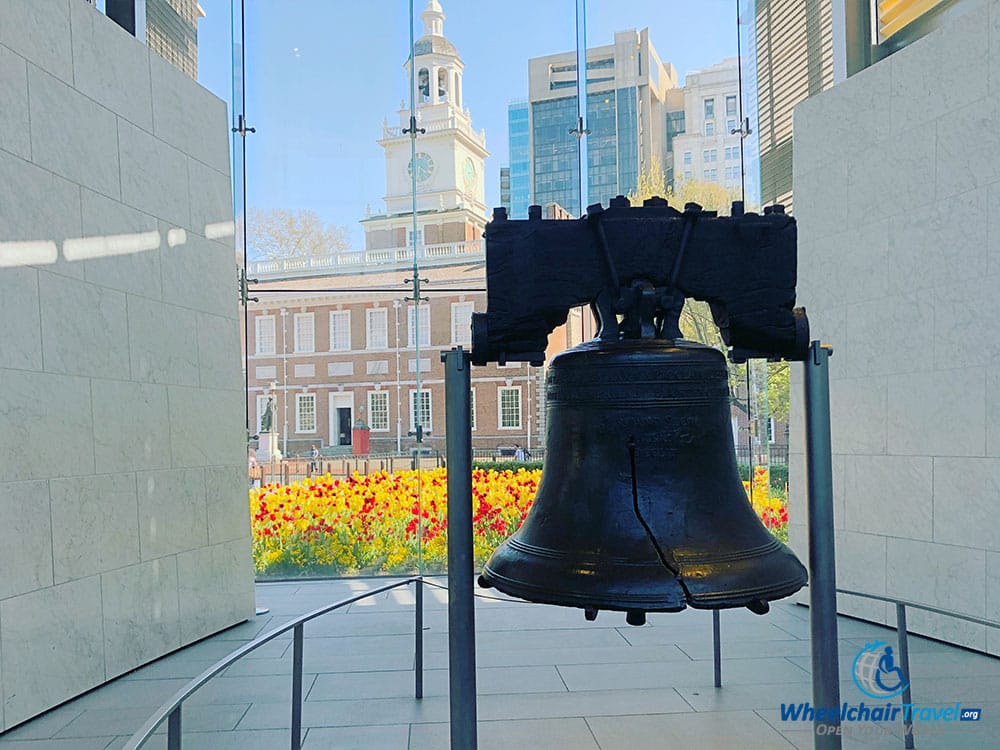
The Bell achieved great fame in the late 1800s and early 1900s, when it was sent across the country to various expositions and patriotic events. During World War II, the bell’s image was used in marketing materials for the sale of war bonds.
Following World War II, the City of Philadelphia turned the bell over to the National Park Service, who have made it a focal point of Independence National Historic Park. Now housed in the Liberty Bell Center just steps from Independence Hall, the bell is visited by millions of people each year. Admission is free, and the Liberty Bell Center is open daily, except on Christmas. A security screening (with a light pat down for wheelchair users) is required.
For more information, visit the Liberty Bell Center website at www.nps.gov.
National Constitution Center
Located just a few blocks away from Independence Hall, the National Constitution Center is the most complete historical museum focused on America’s founding document.
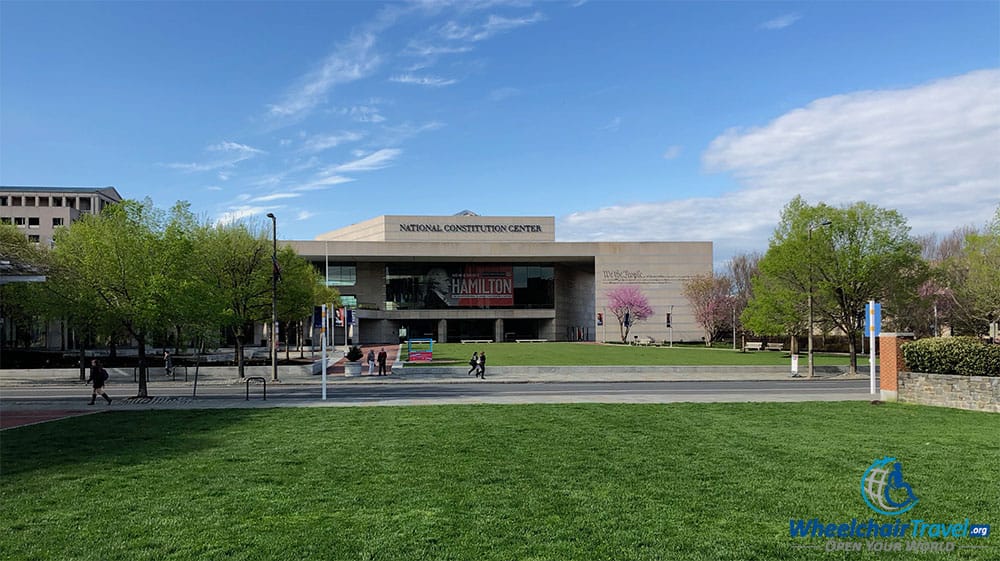
Opened in 2003, the Constitution Center makes its home in a modern building that is fully wheelchair accessible. Three permanent exhibits trace the history of the United States government, from the Articles of Confederation through the most recent amendment, which was introduced in 1789, but not ratified until 1992.
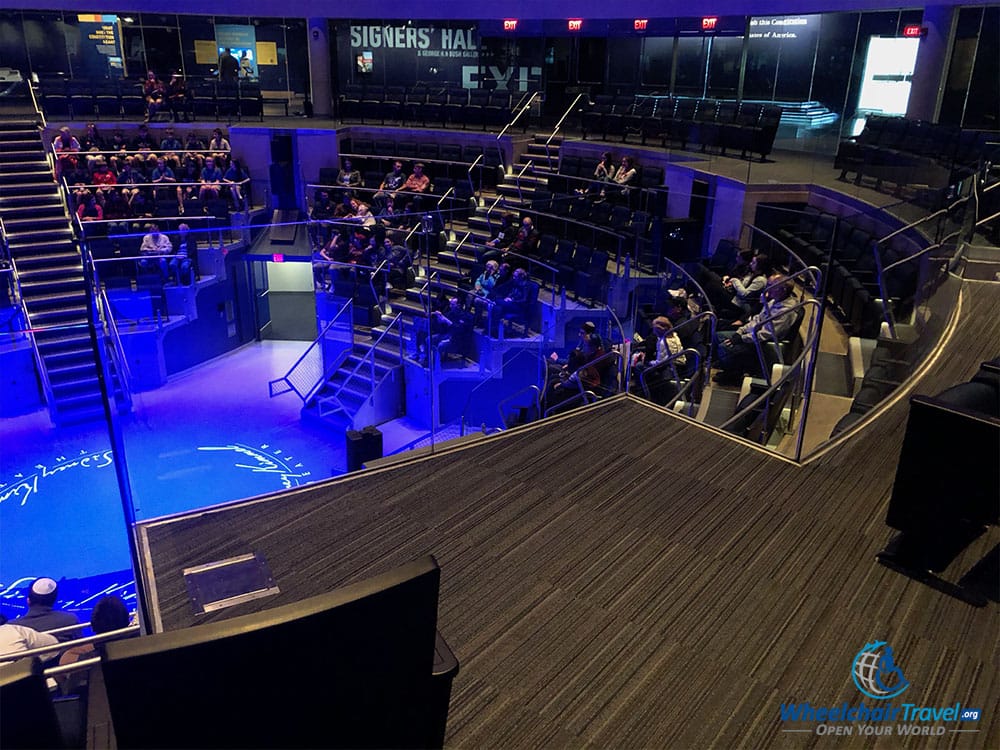
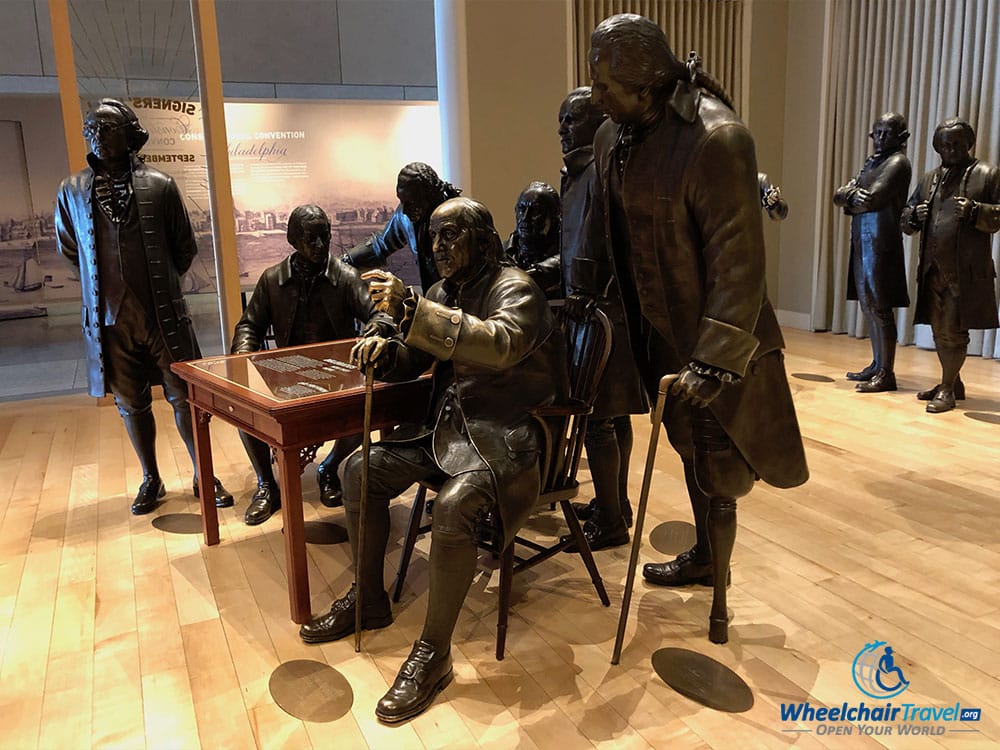
Visitors should begin their tour with Freedom Rising, a theatrical production that takes place in the multi-level circular Sidney Kimmel Theater. Following the performance, which lasts approximately 17 minutes, visitors will be directed into “The Story of We the People,” an expensive exhibit containing historical information and artifacts, interactive components and an interesting mock polling booth that sheds light on the political positions of past presidents. The final permanent exhibit, Signers’ Hall, contains full-size statues of the delegates to the Constitutional Convention. Pictured above are the statues of the Pennsylvania delegation, which included Benjamin Franklin.
Admission to the National Constitution Center is $14.50 for adults and $13 for seniors (age 65+), with discounted admission for students, veterans, children and teachers. For more information, visit the center’s website at www.constitutioncenter.org.
Museum of the American Revolution
Opened in 2017, the Museum of the American Revolution is a worthy addition to Philadelphia’s museumscape. With a wide-ranging collection of artifacts dating to the Revolutionary War era, including artwork, sculpture, textiles, manuscripts, books and correspondence, the museum’s exhibits allow visitors to see history in a truly meaningful way.
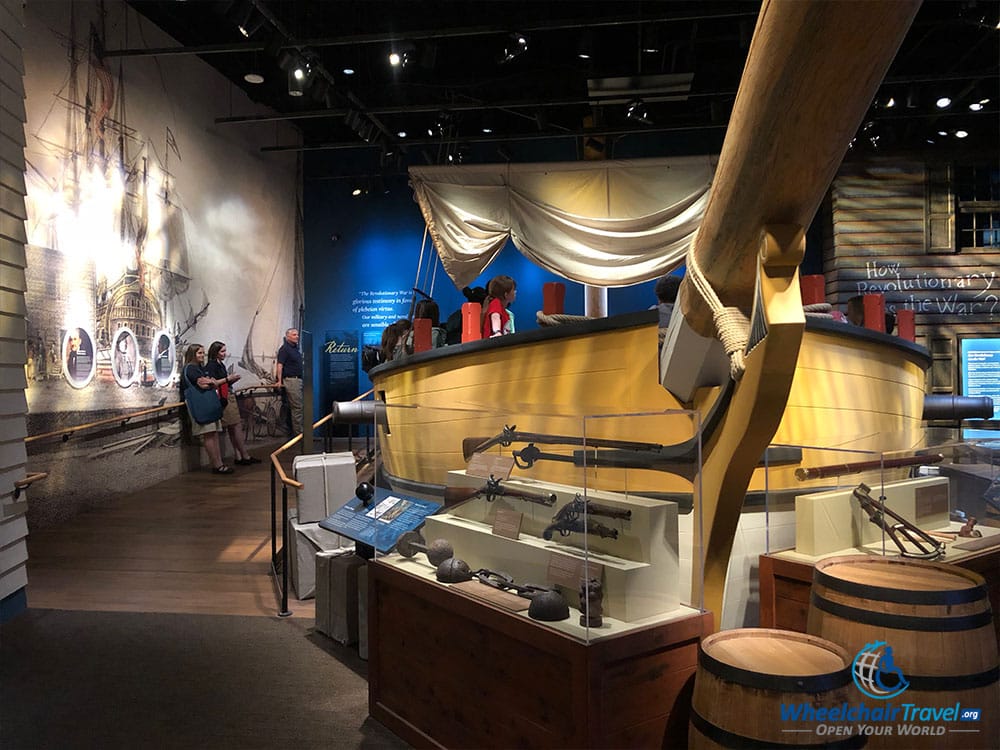
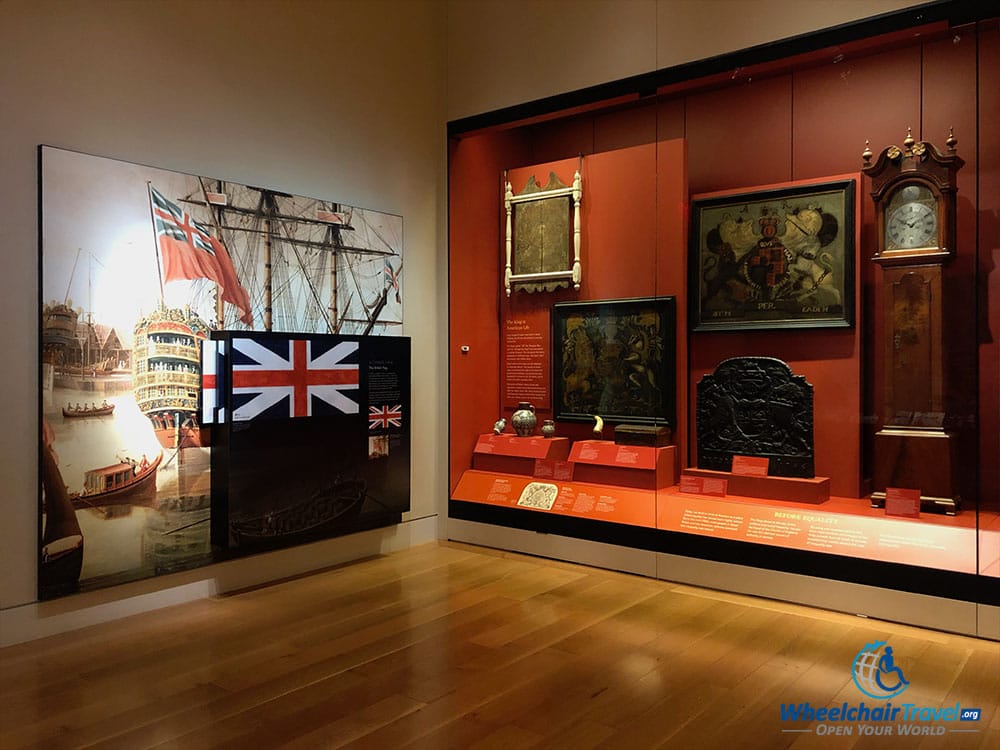
The museum’s most popular exhibit is George Washington’s office and sleeping tent, used during the Revolutionary War, and popularly referred to as the first “Oval Office.”
Museum admission costs $19 for adults and $17 for seniors (age 65+). Personal care attendants are admitted free of charge. For more information, visit www.amrevmuseum.org.
Eastern State Penitentiary
Opened in 1829, the Eastern State Penitentiary was designed to reform (rather than punish) criminals. It was one of the first prisons, and most certainly the largest, to experiment with the practice of separate incarceration, where each prisoner was given his own cell and exercise area, and denied the opportunity to see or interact with other inmates.
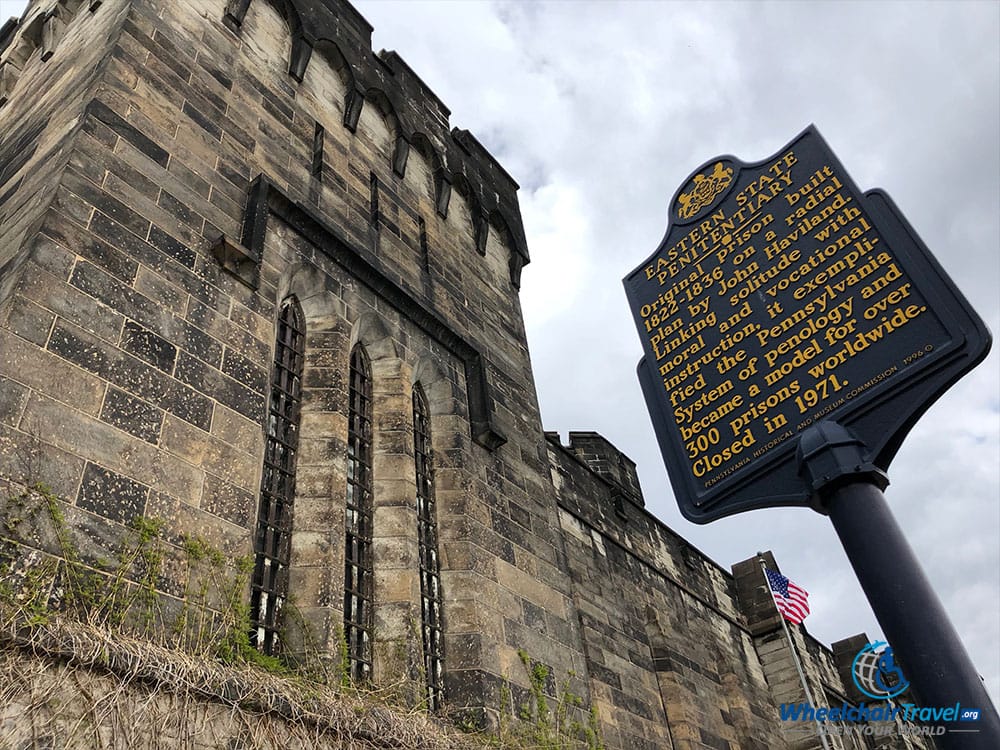
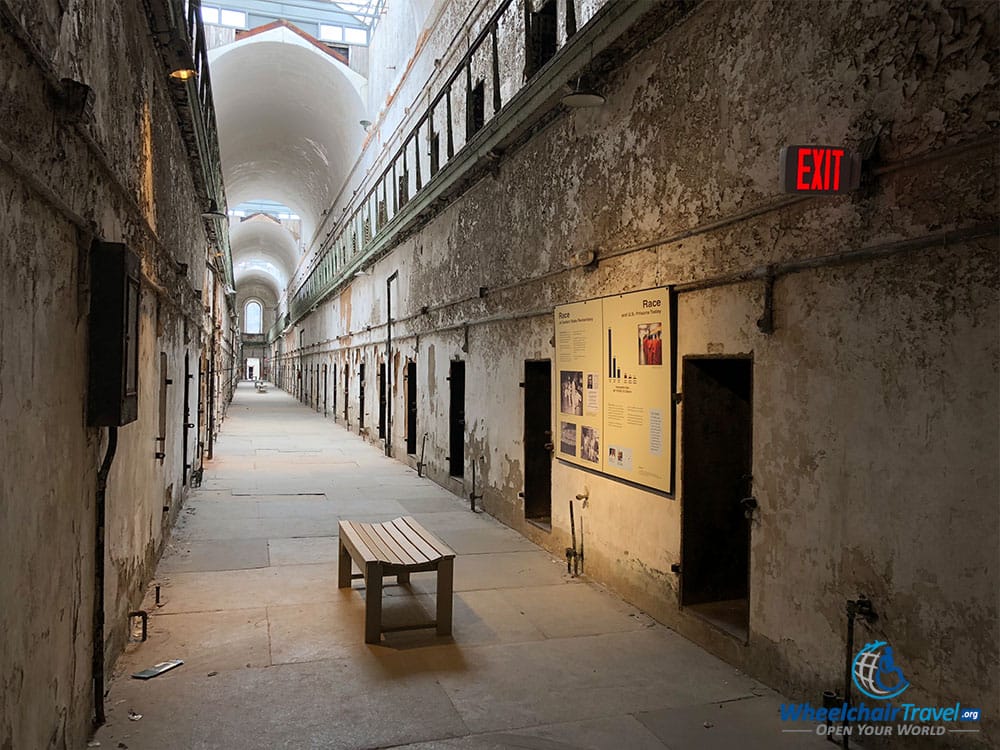
As the prison population grew, Eastern State was forced to pursue a rapid expansion, adding new cell blocks and, ultimately, building a second story. When overcrowding became a serious issue, the prison’s founding principle—prisoner isolation—had to be abandoned. In 1971, after having been used for almost 150 years, Eastern State Penitentiary was closed. The prison, which was once home to notorious mobster Al Capone, was left abandoned for nearly two decades after it closed. In the early 1990s, it found new life as a tourist attraction and museum, and remains a popular tourist attraction today.
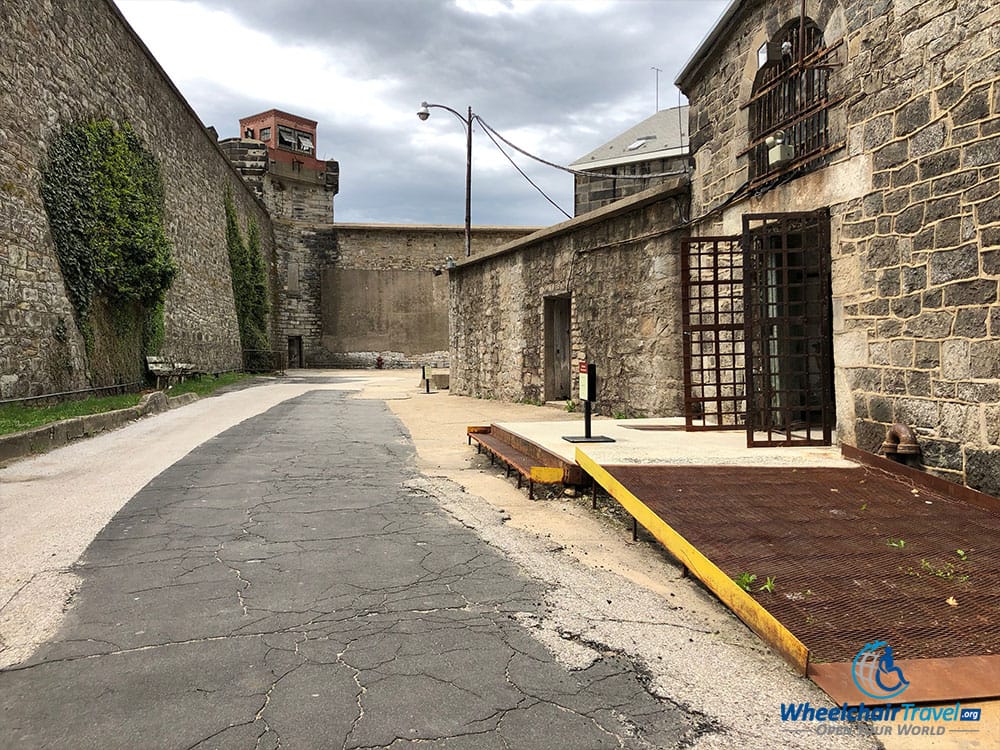

The museum tour is mostly wheelchair accessible, with barrier-free entry to the first floor of every cell block. However, wheelchair users will be unable to access the upper floors of cell blocks. Entry into individual cells is also not possible, except for able-bodied persons who can step over thresholds of up to one foot. The bathrooms at the facility are also not accessible, and I only found a porta-potty that could accommodate a wheelchair. Although Eastern State is a U.S. National Historic Landmark, additional work should be done to increase accessibility.
Admission to the Eastern State Penitentiary, which includes an audio tour, costs $16 for adults and $14 for seniors (age 62+). A $2 discount on admission is available when purchasing tickets online. Please note that the gift shop/ticket office is not wheelchair accessible, but a member of staff will come outside to assist. If you are a read-everything type tourist, I recommend budgeting two hours for this tour. For more information, visit www.easternstate.org.
Benjamin Franklin Museum
Opened in 2013 and located in Franklin Court (between Market and Chestnut streets), the Benjamin Franklin Museum is administered by the National Park Service and dedicated to expanding knowledge of Philadelphia’s most well-known historical figure.
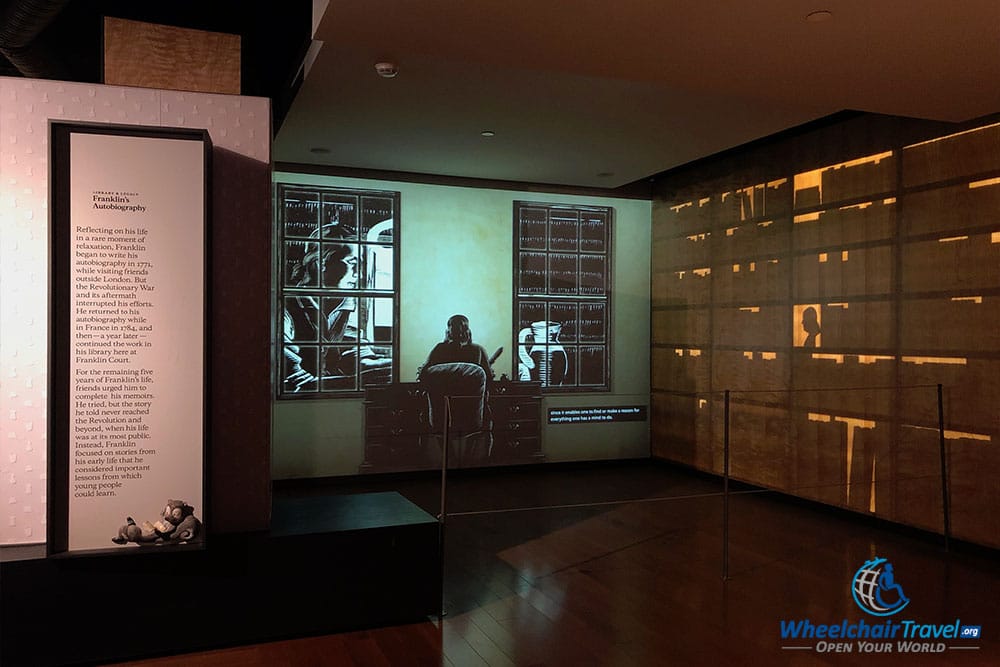
The museum presents Franklin’s life and achievements through a range of interactive features, informative exhibits, original artifacts and reproductions. Visitors are afforded an opportunity to experience many of Franklin’s early creations, while encountering the man through excerpts of his own writings. His inventions and publications provided museum curators with a wide array of material, which is now presented in a way that is accessible to people of all ages.
The museum is wheelchair accessible, with an elevator down to the galleries and ADA compliant bathrooms. Admission to the museum is just $5 for adults. For more information, visit www.nps.gov. I recommend allowing one hour to complete the museum tour.
Betsy Ross House
Built more than 250 years ago, the building at 239 Arch Street was once the home of Betsy Ross, and the place where she created the very first American flag.
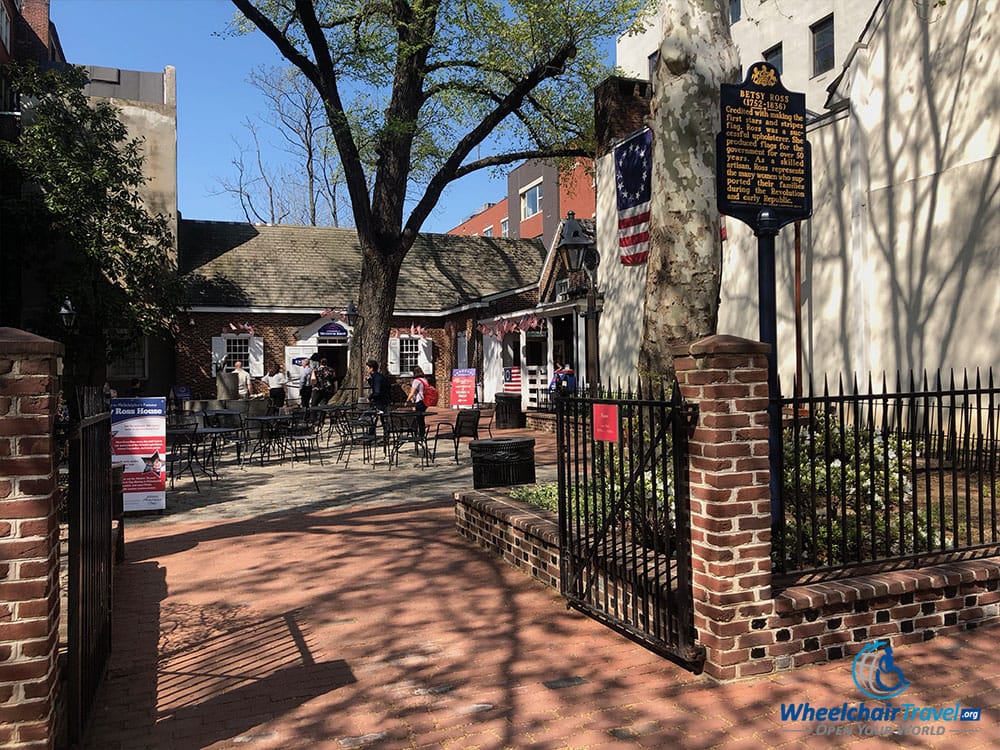
Due to the building’s age, it is not wheelchair accessible. The gift shop and outer courtyard is accessible, however. Betsy Ross’s gravesite is to the left of the home, in the courtyard (pictured above), and it is free to access. For more information, visit www.historicphiladelphia.org.
Philadelphia Museum of Art
With a collection of more than 240,000 works of art, including paintings, statues, sculptures, textiles, photographs, prints and more, the Philadelphia Museum of Art is one of the world’s largest. Opened for the 1876 World’s Fair nearly 150 years ago, the museum is a must visit attraction in Philadelphia.
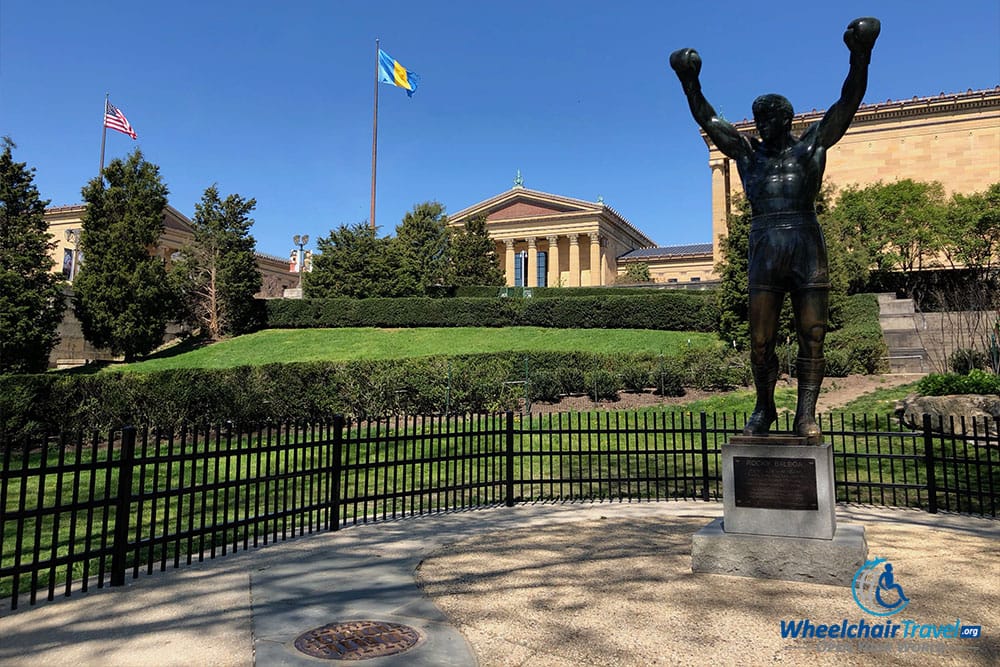
A popular photo spot in front of the museum is the Rocky Balboa statue, depicting Sylvester Stallone’s famous character in the Rocky movie series. This statue and the large staircase leading to the museum’s front entrance are Instagram favorites. Wheelchair users should come to the front to check out the view, but the museum’s accessible entrance is at the rear of the building.
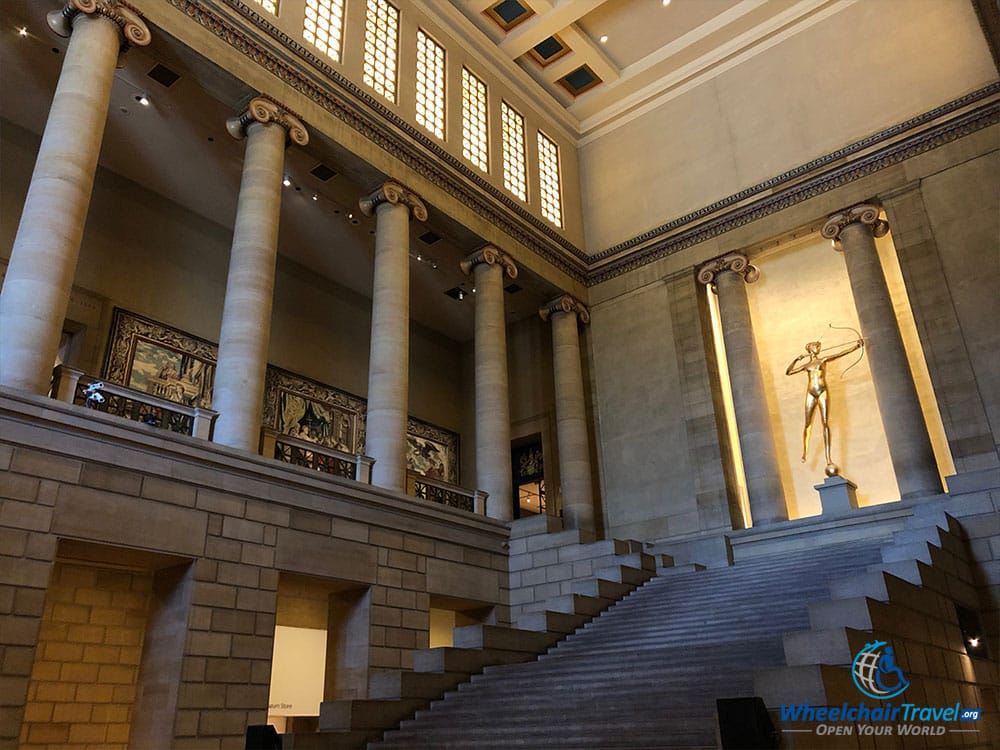
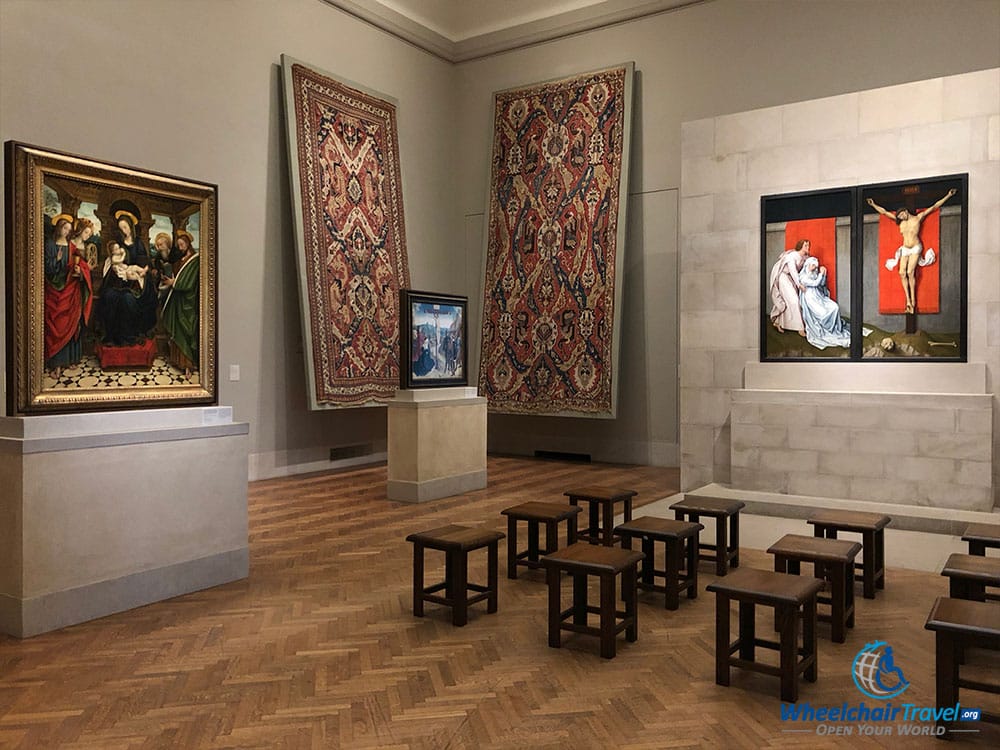
Pictured above is the beautiful grand staircase in the museum’s main atrium. Rest assured, there are elevators to provide wheelchair access to every floor of the museum, and all galleries are wheelchair accessible.
Of all the works on display in the collection, I was most captured by the incredible painting by Rogier van der Weyden, Crucifixion Diptych. Dating to c. 1460, I was amazed at the incredible detail and the painting’s excellent condition. The panel on the left depicts the Blessed Virgin Mary and St. John the Evangelist, while the one on the right depicts the Crucified Christ. Due to the unbalanced appearance of the diptych, some art historians have suggested that a third panel may be missing from what could have been a triptych.
Admission to the Philadelphia Museum of Art costs $20 for adults and $18 for seniors (age 65+), and includes two consecutive days of admission to the main building (described here), Perelman building and Rodin Museum (described below). To learn more, visit the PMoA website at www.philamuseum.org.
Rodin Museum
The Rodin Museum in Philadelphia holds the largest collection of Auguste Rodin’s sculpture works outside of the Musée Rodin in Paris, France, where the artist was born in 1840.

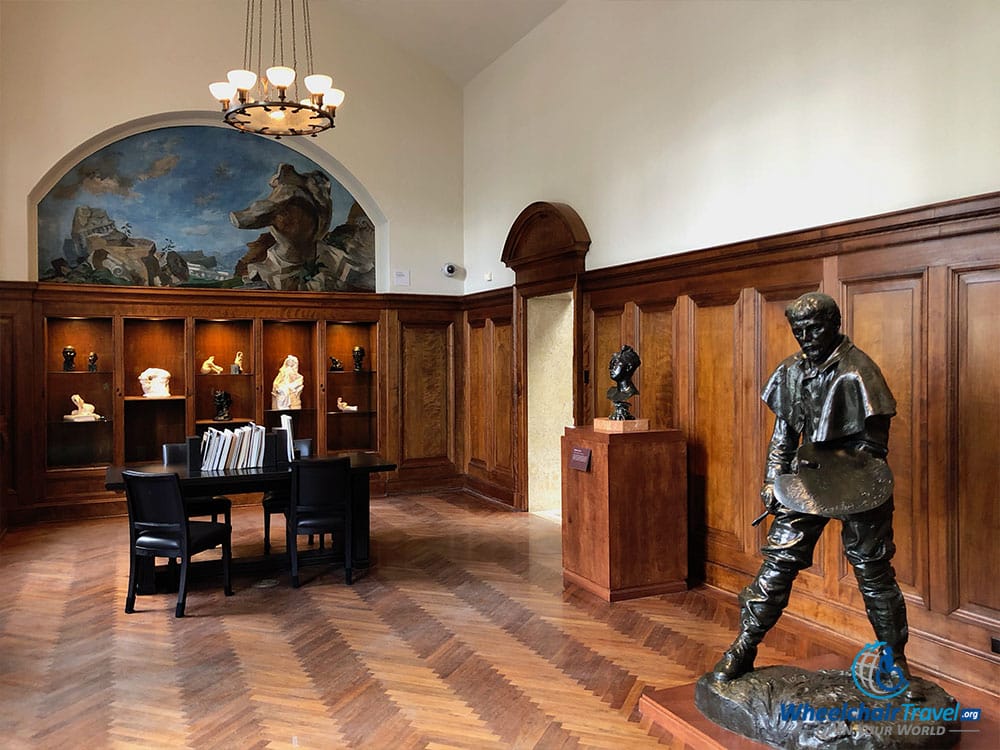
The galleries have been artfully arranged, providing a fantastic setting to enjoy the sculptures. Among the notable pieces on display are Colossal Head of Balzac, Eternal Springtime, Jules Bastien-Lepage and Mask of the Man with the Broken Nose.
Admission to the Rodin Museum is included with admission to the Philadelphia Museum of Art. While the front entrance of the building is not wheelchair accessible due to steps, wheelchair users can gain entry by following a path around the right side of the building. An accessible entrance is located at the rear – press the button to alert team members, who will arrive to open the door within moments. For more information, visit www.rodinmuseum.org.
Barnes Foundation
There are many choices of art galleries in Philadelphia, but the collection on display at the Barnes Foundation is one of my favorites in the United States. The gallery bills itself as being home to “one of the world’s greatest collections of impressionist, post-impressionist and early modern paintings,” and even the most ardent art critic would find it hard to disagree.
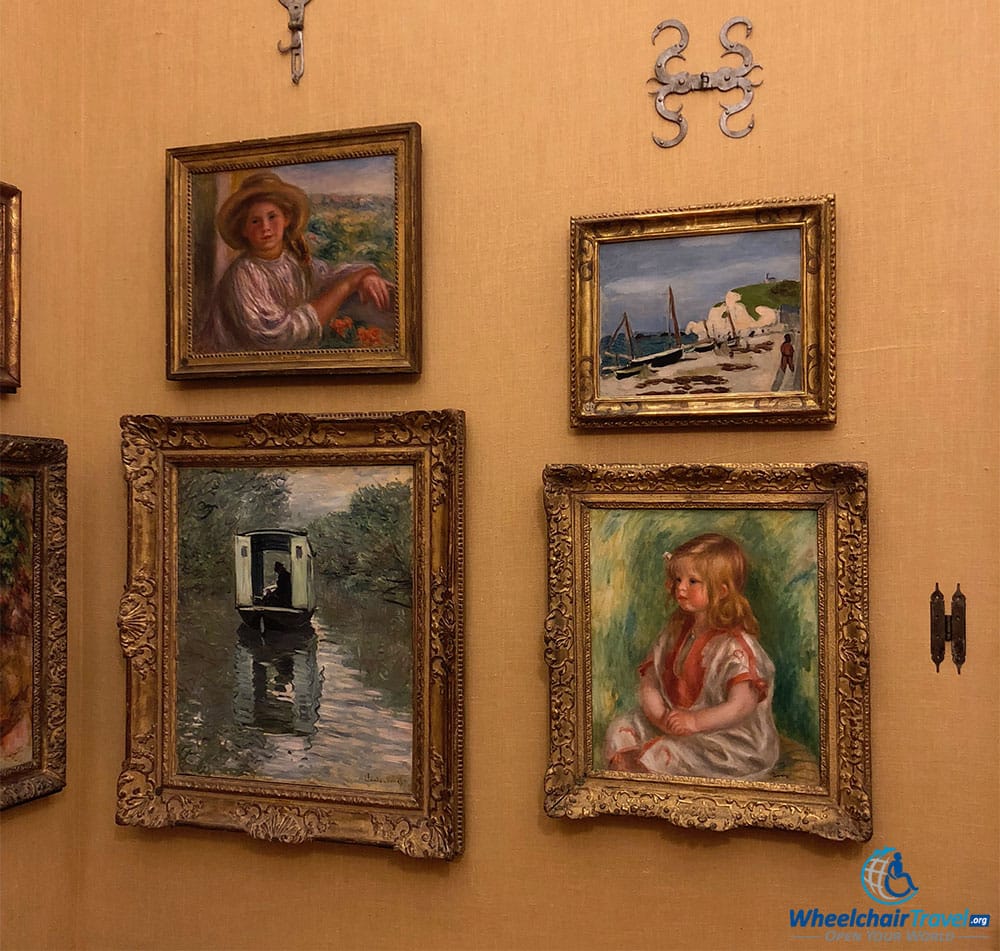
The photograph above depicts four paintings that I would love to own, from three of my favorite impressionist painters. From the top left, clockwise: Girl on a Balcony, Cagnes by Pierre-Auguste Renoir; The Black Boat by Henri Matisse; Claude Renoir by Pierre-Auguste Renoir; and The Studio Boat by Claude Monet.
You will see incredible works like these, and many more, at the Barnes Foundation. The cost of admission is $30 for adults and $28 for seniors (age 65+). There was ample space to accommodate my power wheelchair in all galleries, though some of the galleries and doorways are small. For more information on the collection, visit www.barnesfoundation.org.
Franklin Institute
The Franklin Institute is a science museum that was founded in 1874, and is included on many Philadelphia tourist itineraries. The scope of the museum’s exhibits extends well beyond Franklin’s own scientific work. The collection includes a significant number of artifacts from the Wright brothers, including an original 1911 Model B airplane, a two-seater biplane of which approximately 100 were built.
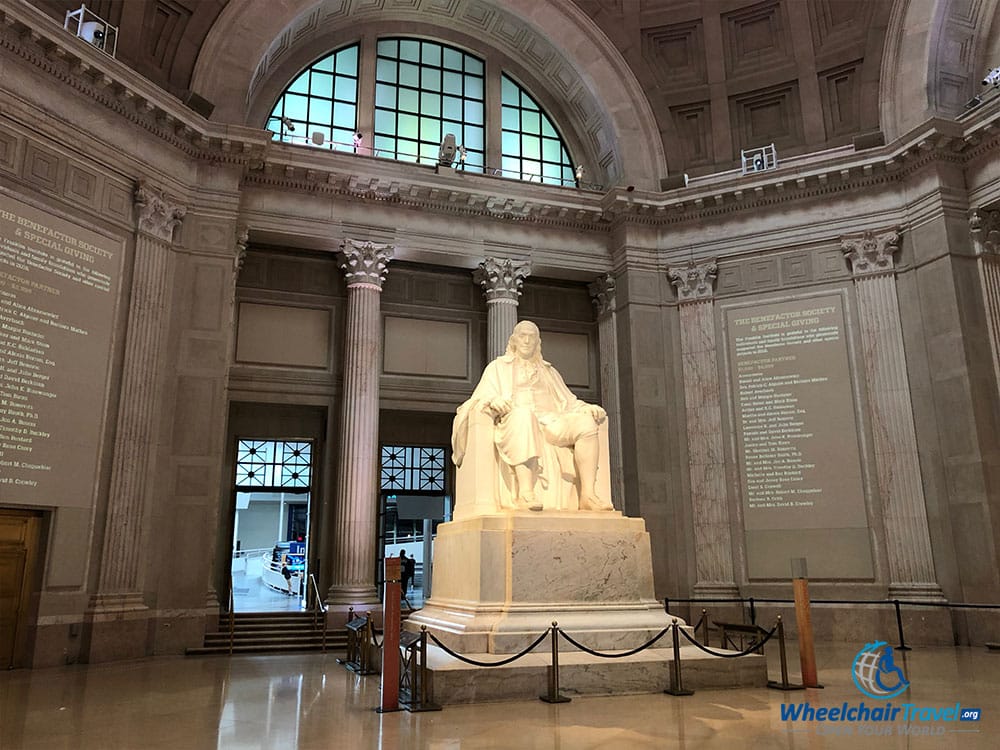
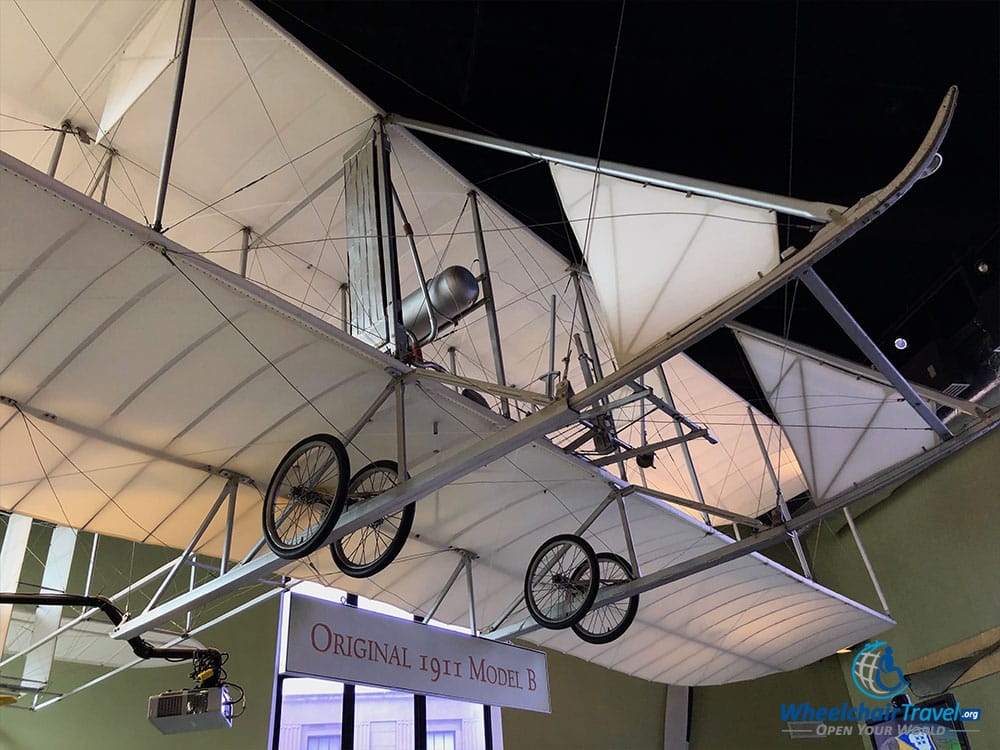
Behind the museum admissions desk, visitors will find a great hall containing a 20-foot high statue of Benjamin Franklin, created by sculptor James Earle Fraser. The hall, and the towering statue of Franklin, constitute what congress designated in 1972 as the Benjamin Franklin National Memorial.
The cost of general admission is $23 for adults. Special exhibits and the IMAX theater carry an additional charge. For more information, visit www.fi.edu.
National Museum of American Jewish History
Located on the corner of 5th and Market Streets, the National Museum of American Jewish history sheds light on the history of Judaism in the United States, from the colonial period up to the present day. The museum’s permanent exhibits trace Jewish immigration in the late 1800s and early 1900s and the contributions of Jews to the economy, political movements and the arts.
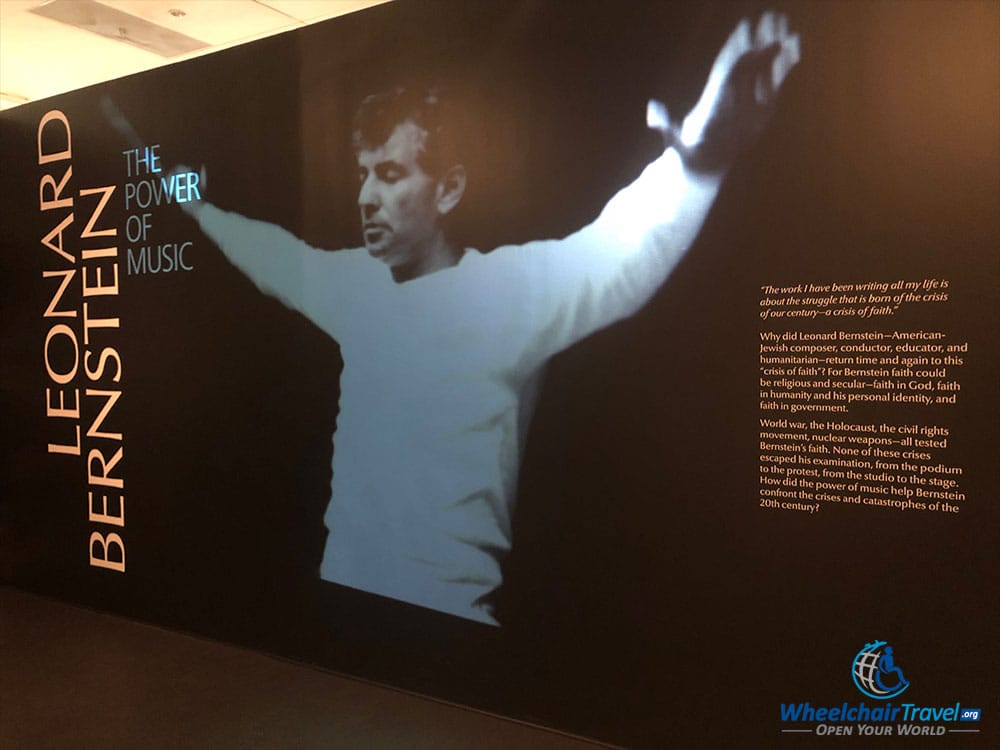
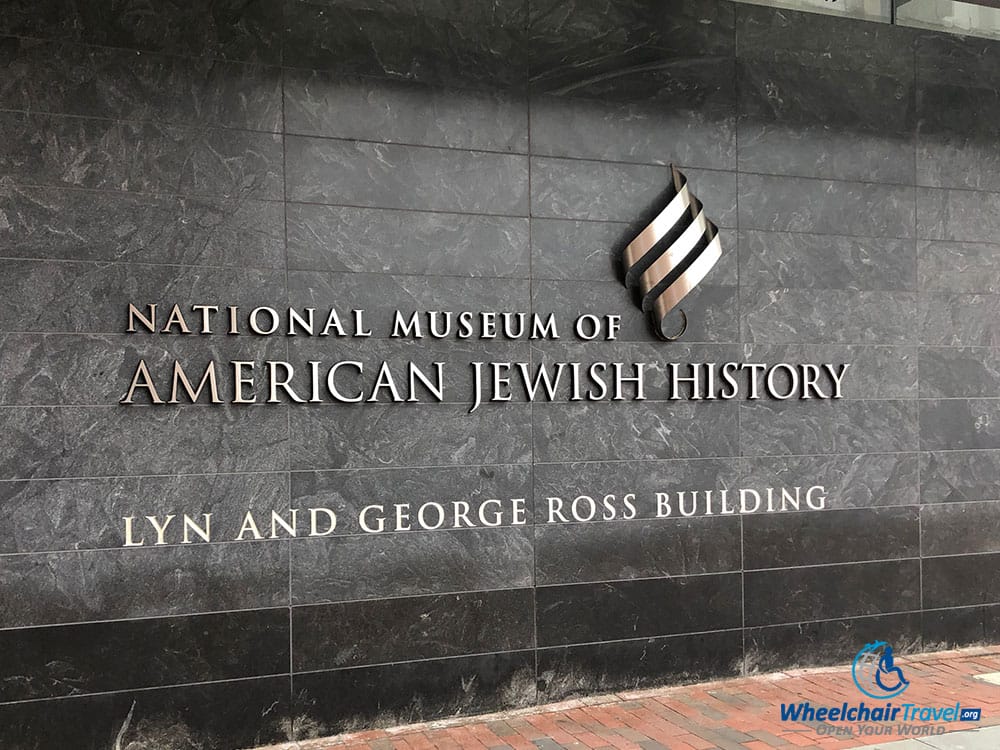
Of particular interest is the special exhibition, Leonard Bernstein: The Power of Music, which will run through September 2, 2018. On October 11, The Art of Rube Goldberg will open, showcasing the artist’s countless contributions to American life.
The National Museum of American Jewish History is affiliated with the Smithsonian Institution. Admission to the museum is $15 for adults and $13 for seniors (age 65+). For more information, visit www.nmajh.org.
African American Museum in Philadelphia
Visitors to the African American Museum in Philadelphia will encounter a series of interactive exhibits that shed light on the African American experience in America across a long period of time – from the colonial period, through the American Revolution, during the civil war, Reconstruction, the civil rights movements of the 1960s and into more recent times.
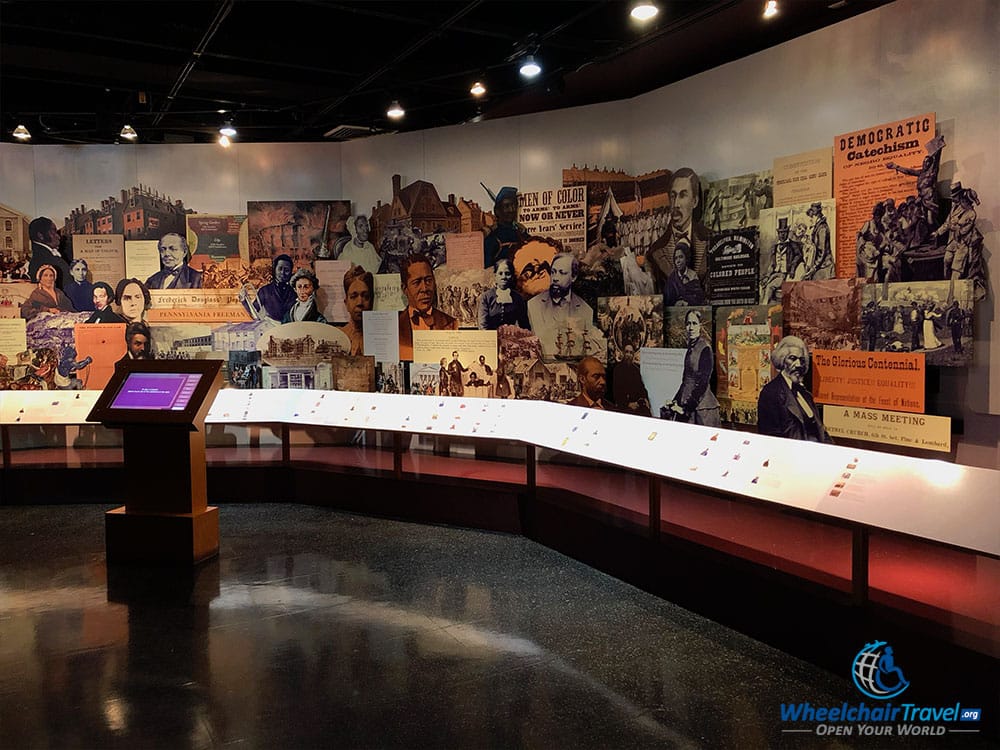
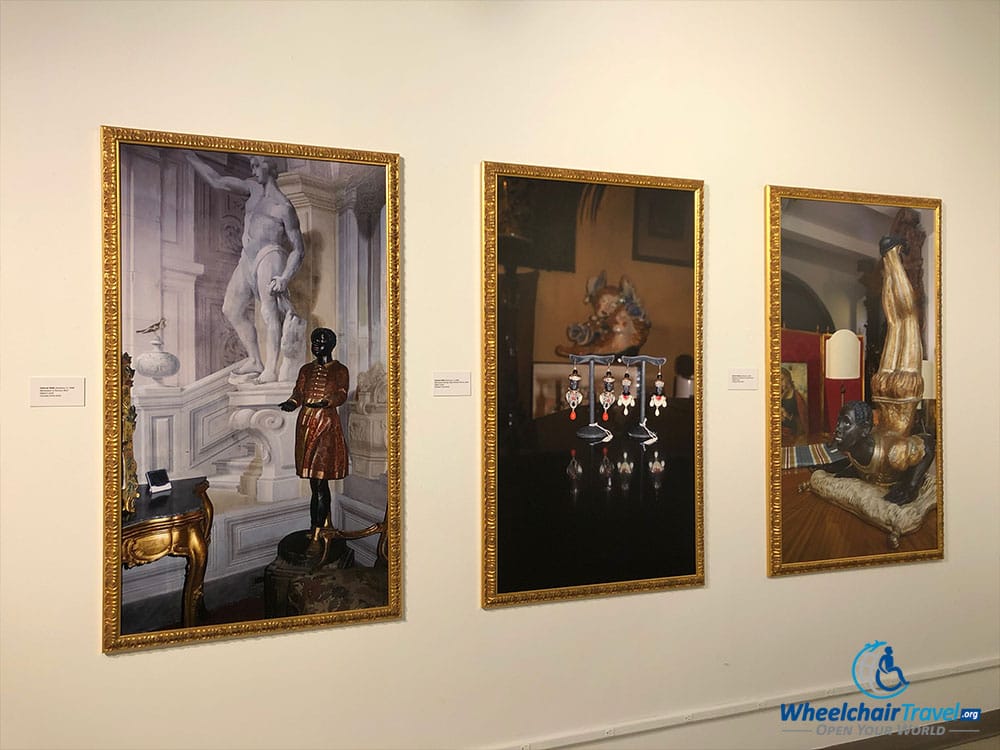
Each time you visit, the content will evolve, with a rotating series of temporary exhibits added frequently. When I visited, there was a fantastic temporary exhibit featuring the works of photographer Deborah Willis. The exhibit, titled Went Looking for Beauty: Refashioning Self, contains “images that question history an interrogate the foundations of beauty.”
While there are no elevators at the museum, ramps connect each floor and allow for wheelchair access. All of the exhibits have been designed with accessibility in mind. Admission is priced at $14 for adults and $10 for seniors. For more information, visit www.aampmuseum.org.
LOVE Park
The LOVE sculpture, created by artist Robert Indiana, is one of Philadelphia’s most iconic tourist attractions. The statue was first placed in Robert F. Kennedy Plaza in 1976, where it is now a permanent fixture.
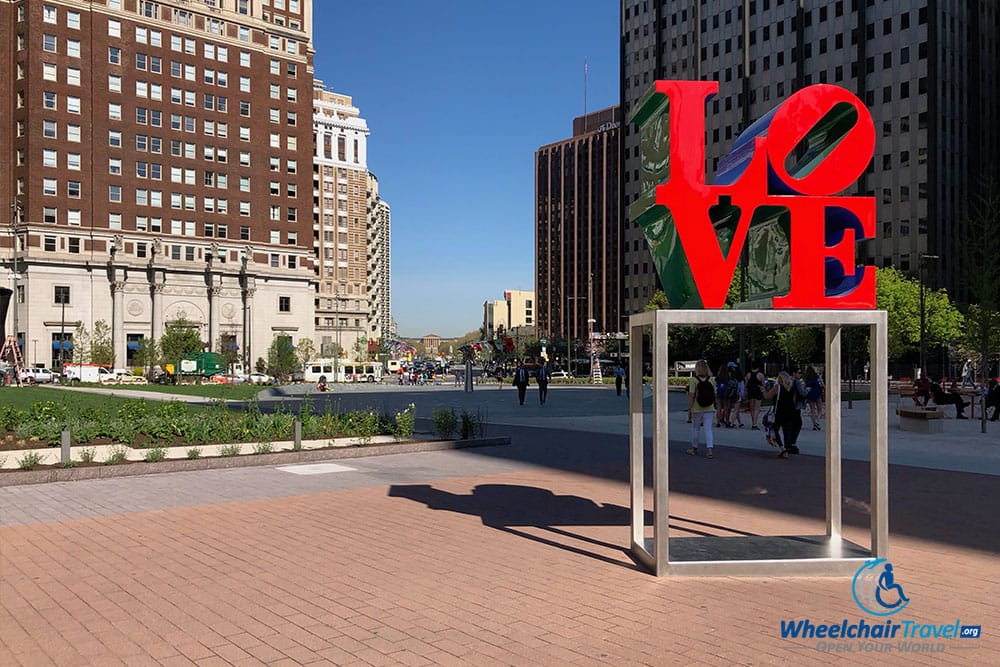
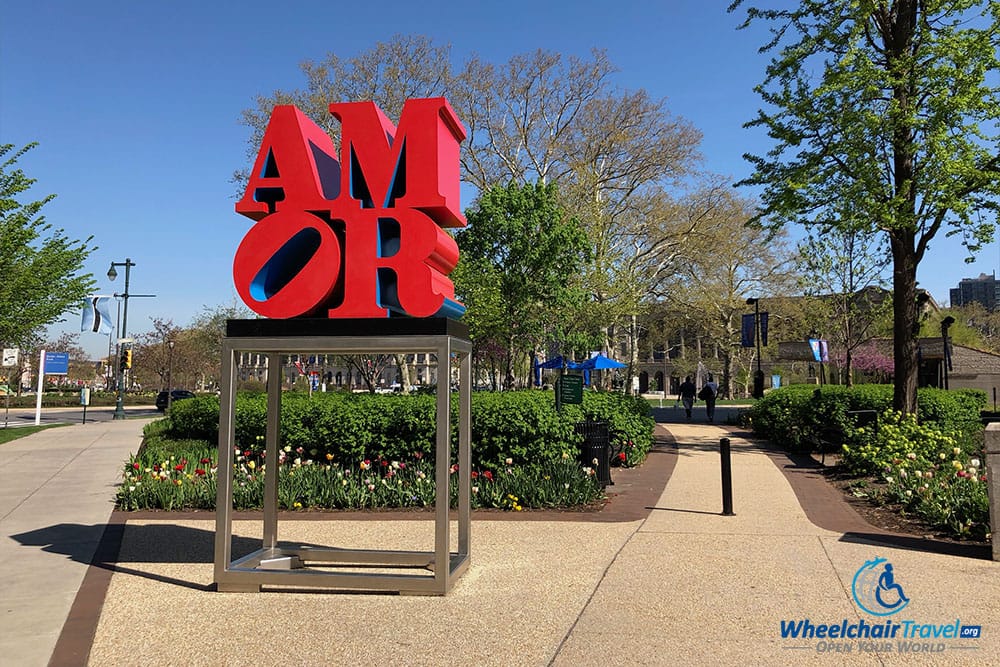
A few blocks away, in Sister Cities Park at 18th Street and the Benjamin Franklin Parkway, visitors can see AMOR, Robert Indiana’s bilingual counterpart to LOVE. The AMOR sculpture was first unveiled in September, 2015, to mark the visit by Pope Francis for the Roman Catholic Church’s World Meeting of Families Congress.
Reading Terminal Market
Open since 1893 in a National Historic Landmark building, the Reading Terminal Market is a stop that must be included on every Philadelphia itinerary. Inside, visitors will find more than 70 merchants selling a wide variety of goods, including freshly prepared food, meat, seafood, chocolate, baked goods, souvenirs, household linens, flowers, cookbooks and more.
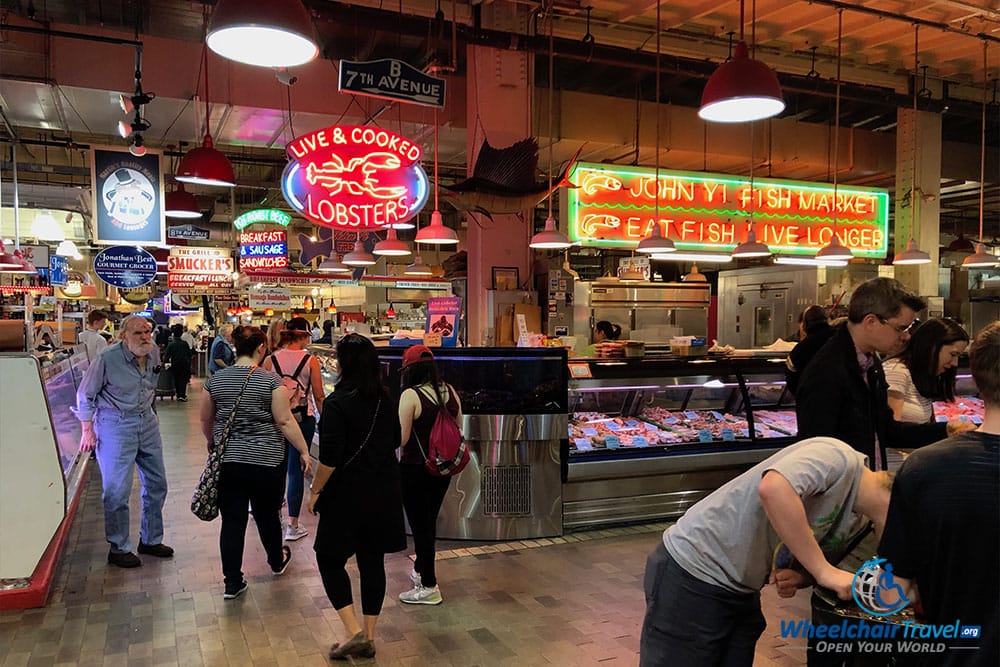
Although the market is especially crowded during the lunch hour, I strongly recommend you stop by. I assembled a fantastic lunch, with a half rotisserie chicken from Dienner’s BBQ Chicken, fries from Spataro’s and an ice cream cone from Miller’s Twist.
The market has plenty of tables tables to sit down and enjoy a meal, as well as wheelchair accessible bathrooms. Its central location, at 51 North 12th Street, means you won’t have to go out of the way to enjoy one of the country’s oldest public markets. For more information, visit www.readingterminalmarket.org.
The Best Philly Cheesesteaks
Foodies from around the world travel to Philadelphia to try the cheesesteak and, while I am not a legitimate foodie, I do enjoy the city’s famous delicacy. As you can imagine, there is much debate over where to find the best cheesesteak. I do have an opinion, but I’d love to hear what you think in the comments below.
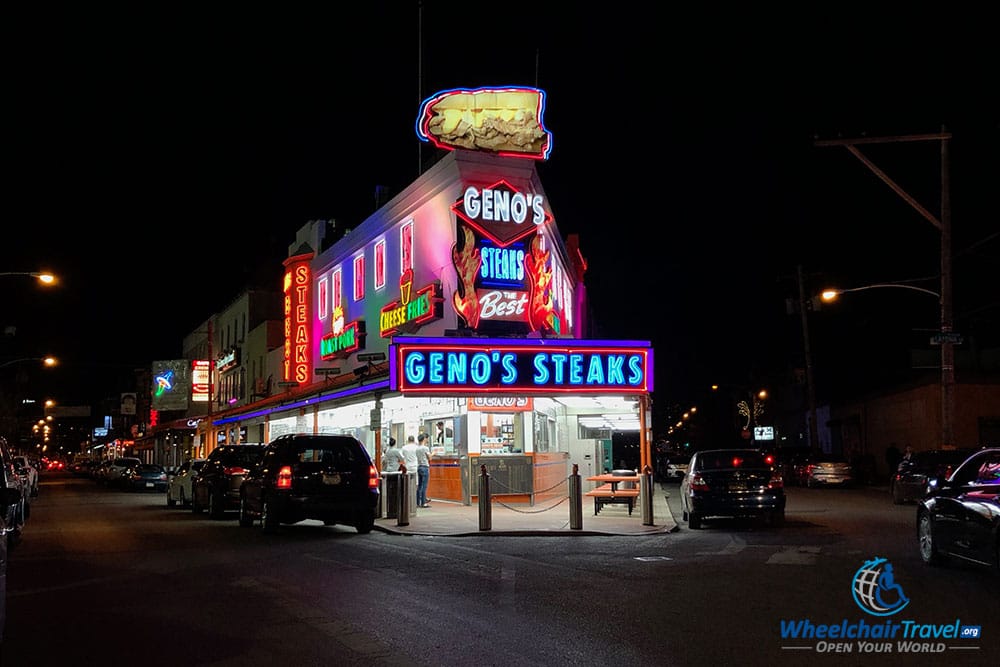
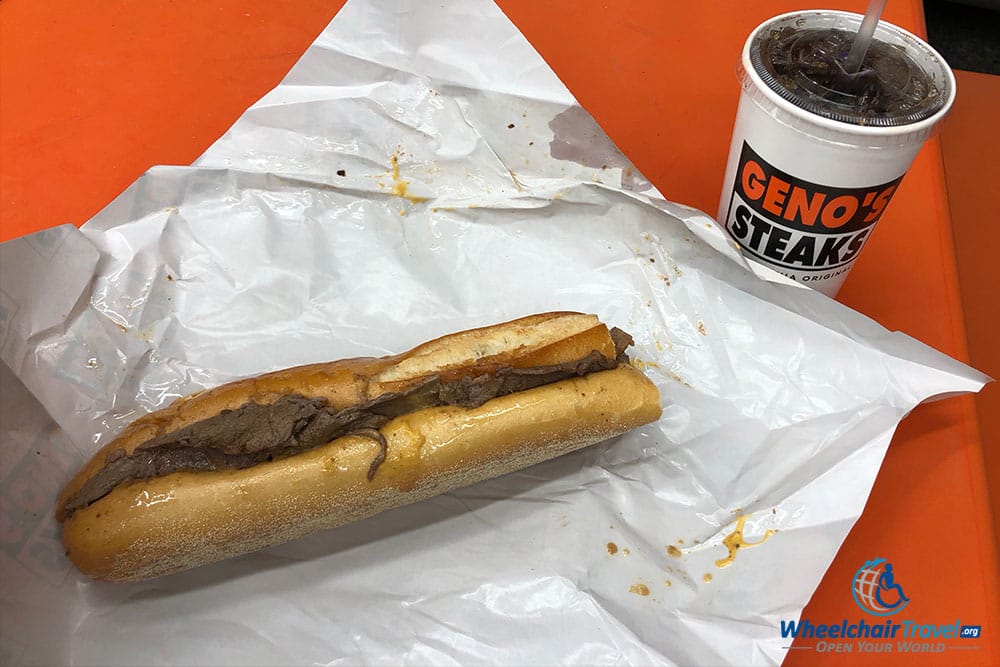
There are two big names on the Philly Cheesesteak scene: Pat’s King of Steaks (the original) and Geno’s Steaks (whose founder also claimed to be the creator). Both Pat’s and Geno’s grill steaks around the clock, and the rivals are conveniently located on opposite corners of 9th Street & Passyunk Avenue. Try both in one night, if you must! My favorite, pictured above, is Geno’s. What’s yours?
For a list of the 10 best cheesesteak joints in Philadelphia, check out this article from Visit Philly.



